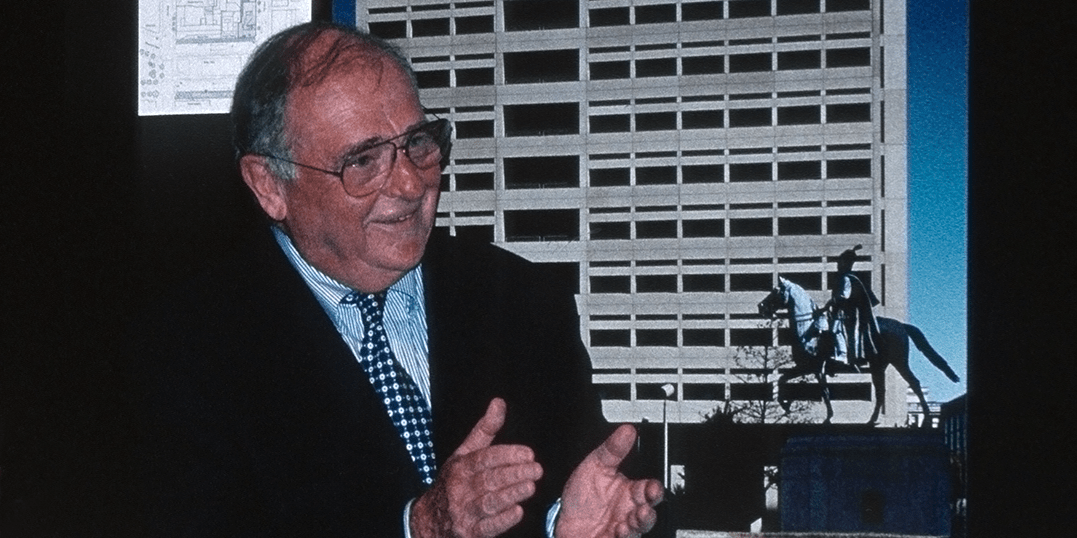Upcoming Special Event
Remembering Professor Emeritus B. Frank Schlesinger, FAIA
Join faculty, staff, alumni and friends as we pay tribute to Frank Schlesinger. Program details and registration, here.
April 23, 2021 at 4:30 PM
An architect’s legacy lives on in the structures amassed over a lifetime of shaping city skylines. But in the case of Frank Schlesinger, who was notably one of the region’s most acclaimed architects, his legacy stretches beyond the concrete and glass he shaped throughout his career to include a product decidedly more human: a generation of architects who followed him.
Frank Schlesinger, FAIA, who died March 4, 2021, was a mainstay in Maryland’s Architecture Program for over 20 years, where he leveraged his experience, values and design principles to instill a standard of excellence that resonated with hundreds of alumni practicing today.
A graduate of Harvard University’s Master of Architecture Program, Schlesinger worked with a number of notable architects—including Louis Kahn and Marcel Breuer—before setting up a small but exemplary practice, Schlesinger and Associates, in Washington, D.C., in the late 60s. He came to Maryland’s newly established Architecture Program first as a Kea Professor and frequent critic in 1971, then was hired a year later by John Hill to join the faculty ranks. Schlesinger’s arrival, in many ways, signaled the school’s arrival as well. Frank was one of a handful of faculty who were first and foremost practicing architects; together with colleagues like Roger Lewis, FAIA, Schlesinger could adeptly navigate the architectural zeitgeist and bring a forward-thinking design philosophy and approach to studio. His highly decorated career brought a level of pedigree to the fledgling program and etched a ‘starchitect’ reputation in the eyes of the school’s first students.
“I think the day that the program became important was the day he joined the school,” says former student and D.C. architect, Stephen Muse, FAIA.
Students who didn’t know Schlesinger by reputation became quickly acquainted through his crits, which ran the gamut from thoughtful to searing. Schlesinger had high expectations for students and the rigor of their work and was known to not mince words.
“I remember, during one jury, Frank turned to the student presenting, looked at him squarely and said, ‘are you serious about this?’” said Muse. “When he said he was, Frank simply left the room.”
“He was certainly a very good critic,” said Lewis, a longtime friend and colleague. “He always had very good comments but he didn’t spin a lot of poetic phrases. He was a practical guy and the students appreciated that.”
Muse recalls a paradigm shift the day Schlesinger brought a set of drawings from his practice to school and pinned them on the wall of the studio. Seeing the meticulous attention to detail and thoughtful programming, says Muse, was a breakthrough moment.
“It was a professor saying to us—showing us— ‘This is what we do, as architects.’ Frank expected of us exactly what he expects of himself. And you can’t ask for more than that.”
Schlesinger effectively bridged exceptional careers in teaching and practice, often blurring the lines for the benefit of his students. Two of the three architects on staff in his nationally-recognized shop in the 1980s were alums, Cindy Frank (M.ARCH ‘87) and Larysa Kurylas (B.ARCH ’80). He would bring students in to help out when deadlines were tight and adeptly channeled his collective experiences to guide students to be better practitioners. He possessed an ease and fluency in architecture that was illustrated in an ability to read and understand drawings and see things his students could not.
“He had an incredible quality to his work and attention to detail, which I think was intimidating to students because he could focus on so many things at once,” says Cindy Frank, who worked for Schlesinger for three years. “But that’s what made him such a great architect and teacher; he could take in the big picture and details at the same time. You’d think to yourself, ‘why didn’t I see that?’”
“Frank was the best I’ve ever seen in terms of a student putting their work on the wall and within seconds figuring out what’s good and what’s bad and what he would recommend about how to work the project,” said Muse. “He took teaching really, really seriously and he was very good at it. There’s no way I would be doing what I’m doing today without Frank. His words are in my work every day.”
Schlesinger continued to teach at the School until his retirement in 2001. Despite being an early faculty member, Lewis says he wasn’t as interested in building the program as he was in building really good architects. Some of the school’s most established, notable alumni learned how to be good designers with the help of Frank Schlesinger.
“Frank’s love was to practice architecture and design real buildings, and he liked sharing that with students,” said Lewis. “His legacy, really, is not so much manifested today in what you see in the school. Rather, it’s the impact he had on a whole lot of students.”

